
The Alamo Plaza Historic District is an historic district of downtown San Antonio in the U.S. state of Texas. It was listed on the National Register of Historic Places in 1977. It includes the Alamo, which is a separately listed Registered Historic Place and a U.S. National Historic Landmark.

The Cass Park Historic District is a historic district in Midtown Detroit, Michigan, consisting of 25 buildings along the streets of Temple, Ledyard, and 2nd, surrounding Cass Park. It was listed on the National Register of Historic Places in 2005 and designated a city of Detroit historic district in 2016.

Flanley's Block is a historic commercial building at 349–353 Main Street in Wakefield, Massachusetts, US. Built about 1895, it is a well-preserved local example of late 19th-century Italianate commercial architecture. The building was listed on the National Register of Historic Places in 1989.
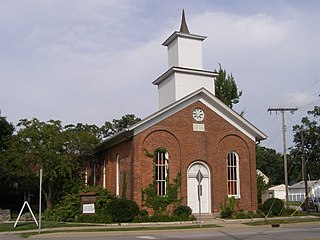
First Unitarian Church of Hobart is the oldest Unitarian Church in Indiana, and the oldest church still occupied by its original congregation in the city of Hobart. It was added to the National Register of Historic Places on September 9, 1999.
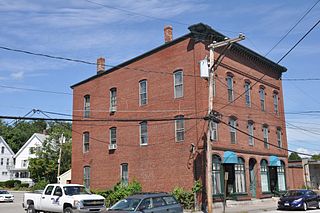
The Jacob Noyes Block is a historic commercial building at 48 Glass Street in the Pembroke side of Suncook, New Hampshire. Built about 1865, it is a distinctive local example of Italianate commercial architecture, and is the largest 19th-century commercial building in the village. It was listed on the National Register of Historic Places in 1986.
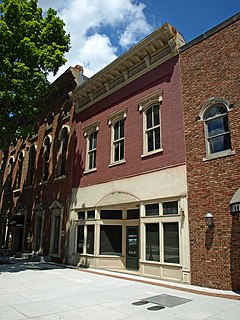
The Rand Building is a historic commercial building in Huntsville, Alabama. Built in 1883, it and the adjacent building, the Donegan Block, represent a simplified Italianate architecture style common in smaller towns in the late 19th century. It is one of few remaining Italianate buildings which once were prevalent on Courthouse Square. The two-story green-painted brick building has an elaborate bracketed metal cornice with decorative panels between the brackets. The street-level façade has large four-pane fixed windows supported by paneled bulkheads, with a central recessed entry. A second row of smaller windows runs above the first, below a smoothed concrete header panel which along which an awning runs the width of the building. On the second floor, three two-over-two sash windows with segmental arched tops are in a frame recessed one course from the rest of the building. It was listed on the National Register of Historic Places in 1980.

The Yarbrough Hotel is a historic building in Huntsville, Alabama. The four-story structure was built of brick and reinforced concrete in 1922–25. The top three floors contain 75 rooms, while the ground floor features the hotel lobby and storefronts; as it did not have a ballroom or party rooms, it catered to businessmen. It faced competition from the Twickenham Hotel one block away, and the Russel Erskine Hotel. Yarbrough operated as a residential hotel until the late 1950s, and was renovated in the 1980s.
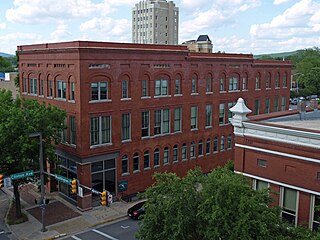
The Dunnavant's Building is a historic commercial building in Huntsville, Alabama. It was built in 1905 by dry goods company Terry Brothers & Rogers. P. S. Dunnavant took control of the company in 1925, and the store remained in its downtown location until 1975. The third floor and roof were damaged in a fire in 1940. The ground floor on the Washington Street façade is framed by large brick piers with polished marble bases. Large display windows flank a recessed entry with a central column flush with the façade. All other windows are one-over-one sashes. A row of small, evenly spaced arched windows line the ground floor along the Clinton Avenue side. On the second floor façade there are two groups of four windows, each group sharing a stone sill. Third floor windows are smaller, and joined by brick arches. Windows along the Clinton Avenue side are similarly treated. The building is topped with a simple, denticulated cornice, with the roofline stepping down towards the rear of the building. The building was listed on the National Register of Historic Places in 1980.

The Everett Building is a historic commercial building in Huntsville, Alabama. Built in 1899, it represents the Commercial Brick style of the late 1800s and early 1900s that eschewed the applied decoration of the Victorian style. The two-story building is divided into five storefronts, although only the southernmost two have entrances today. The upper floor is divided by pilasters between tightly spaced, one-over-one sash windows. Decorative patterned reliefs sit below each window. The building is topped with a parapet that has a course of dentils between courses of stepped brick. The center part of the parapet is raised, and flanked by a short, capped column pieces. The northern bay is visually separated from the others by a pilaster stretching the entire height of the building, and was formerly left unpainted, suggesting it may have been built at another time. A covered, tree-lined alley separates the building from the Yarbrough Hotel to the north. The building was listed on the National Register of Historic Places in 1980.

The Randolph Street Church of Christ is a historic church in Huntsville, Alabama. It was built in 1887 in a Gothic Revival style similar to rural churches, but built of brick. Rather than a central entrance, the tower contains doors under pointed toplights on the sides, and a double lancet window joined under a pointed arch. Another set of lancets flanks the tower. On the corners of the façade and along the side walls are pilasters, dividing the sides into bays with one set of lancets each. The eaves of the gable are corbelled. Above the eaves, the tower is faced with tin, and each side has a pair of arched vents below a small gable. A modern spire and weather vane top the tower. The church sits half a block from Courthouse Square, adjacent to the rear of the Milligan Block. The church was listed on the National Register of Historic Places in 1980.

The Struve–Hay Building is a historic commercial building in Huntsville, Alabama. Built in 1900, it represents a transition between Victorian architecture style and the less ornamented Commercial Brick style. The building was originally two stories with a three-story tower on the corner, but the second story of the Jefferson Street façade was removed in 1955. Previously consisting of two storefronts, the Jefferson Street side was later combined into one, with a recessed central entrance flanked by pilasters and two large single-pane fixed windows on either side. This portion of the building is also painted white with green accents, rather than the red with unpainted stone accents of the remainder of the building, providing additional visual separation. The corner and first bay of either side are adorned with stone pilasters with capitals supporting a stone course that wraps around the building. The tower has a single one-over-one sash window on each face of the second floor, with a pair of small arched windows on the third. It is topped with a pyramidal roof and ball finial. Along Holmes Avenue, the first floor has no windows, while the second floor has a pair of one-over-one windows per bay. The building is topped with a bracketed pressed metal cornice. The roof on the end of the building on the Holmes side steps down to a separate unit, featuring a Romanesque Revival arched entryway below a bay window. The building was listed on the National Register of Historic Places in 1980.

The Schiffman Building is a historic commercial building in Huntsville, Alabama. The main structure of the building was built in 1845. Originally, it was a three-bay brick building divided by large, flat pilasters. The southern bay, at the corner of East Side Square and Eustis Avenue, was remodeled in the Richardsonian Romanesque style in 1895. The other two bays were demolished in the 1970s. Future Speaker of the U.S. House William B. Bankhead used the building as an office while he was Huntsville's city attorney from 1898–1902; his daughter, actress Tallulah Bankhead, was born in the second floor apartment. Issac Schiffman, a businessman and banker, purchased the building in 1905 and it has remained in the family since.
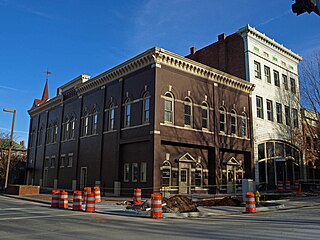
The Milligan Block is a historic commercial building in Huntsville, Alabama. It was built in 1900 and represents the transition from vertically-oriented Italianate style to more restrained, horizontally-oriented commercial styles of the early 20th century. It retains Italianate details such as an applied metal cornice and arched windows, but eschews other applied decoration in favor of using structural elements to provide ornamentation.

The Terry Hutchens Building is a historic office and apartment building in Huntsville, Alabama. The seven story structure was originally constructed in 1925 for the Tennessee Valley Bank, with office space rented to other tenants. In 2002, the upper floors were renovated into condominiums. The structure is of steel reinforced concrete faced with brick, giving a Gothic Revival appearance. The ground floor façade has large display windows separated by brick piers, and has a central, arched entry covered in masonry. The Jefferson Street façade was originally treated the same way, but was modified with a flat wall of thin brick above two storefront entrances. A decorative band with rowlock course brick and terra cotta panels separate the ground floor from the rest of the building. Above, the piers divide each bay containing a pair of one-over-one sash windows; on the seventh floor, a green terra cotta frog sits on the sill, between the windows. Each bay of the cornice is divided by terra cotta decorated with Gothic shapes and medallions on panels of brick. The building was listed on the National Register of Historic Places in 1980.

The James Emery House, also known as Linwood Cottage, is a historic house on Main Street in Bucksport, Maine. An architecturally eclectic mix of Greek Revival, Gothic Revival, and Italianate styling, the house was built c. 1855 on a site overlooking the Penobscot River. It was listed on the National Register of Historic Places in 1974 for its architectural significance.

The Washington County Courthouse is located at 85 Court Street in Machias, the county seat of Washington County, Maine. Now home to the Machias District Court and other county offices, it is an 1853 Italianate brick building designed by Benjamin S. Deane and listed on the National Register of Historic Places in 1976.

The Bank Block is a historic commercial building at 15 Main Street in Dexter, Maine. Built in 1876 for two local banks, with a new fourth floor added in 1896, it is a significant local example of Italianate and Romanesque architecture, designed by Bangor architect George W. Orff. It was listed on the National Register of Historic Places in 1999.
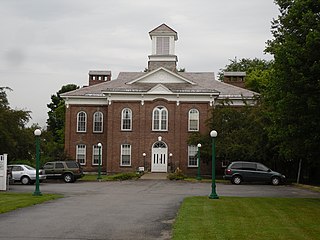
The Poultney Central School is a historic former school building on Main Street in the village center of Poultney, Vermont. Built in 1885, it is a high quality example of Late Victorian Italianate architecture executed in brick. It was listed on the National Register of Historic Places in 1977, and has been converted into residential use.

The Weinmann Block is a commercial building located at 219-223 East Washington Street in Ann Arbor, Michigan. It was listed on the National Register of Historic Places in 1983.

The Michigan Avenue Historic Commercial District is a group of commercial buildings located along the south side of two blocks of Michigan Avenue, from 3301–3461, in Detroit. This section of buildings is the most intact collection along this stretch of Michigan Avenue. The district was listed on the National Register of Historic Places in 2020.

























